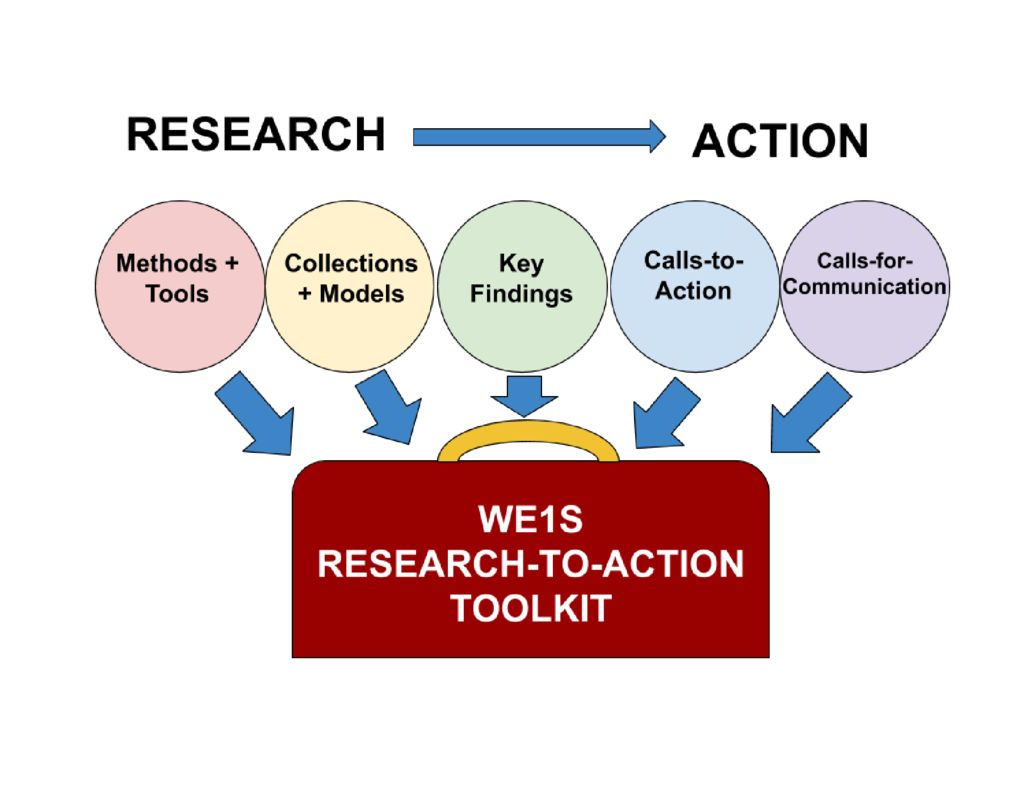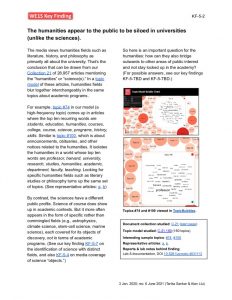WhatEvery1Says is excited to announce that the project will be developing and launching a series of Research-to-Action Toolkits in 2020 to present our research findings. Each Toolkit will be structured with a specific audience in mind, ranging from student journalists to state humanities councils, and will consist of a series of “cards”: easy-to-read, one-page synopses of our methods, findings, and research-based recommendations. Cards are meant to provide a highly visible, portable, flexible, and engaging way for readers to become quickly familiar with our materials and to embark on their own research and advocacy projects. Toolkits will thus act as a mix-and-match modular reporting structure [1] through which we can assemble cards into different configurations oriented towards different audiences. [2]
Examples of WE1S "cards" that will be components of Research-to-Action Toolkits
An important philosophical goal behind each Toolkit is to model a workflow from research to action. A Toolkit begins with a series of cards that introduce a Research Question (or set of questions), provide snapshots of the Tools and Methods that we used to approach the question, describe the specific Collection of materials (such as newspaper articles) that we modelled and analyzed, and highlight the Key Findings that emerged from our research process. A Key Finding, or “answer” to our question, however, is not the last step; crucially, each Toolkit then pivots from what we have found to what audiences might do based on such a finding.
An example helps to illustrate the concept. Let’s say that we examine a collection of thousands of articles drawn from campus newspapers across the country in order to reach a better understanding, for instance, of how college students conceptualize their majors. We might notice that students tend to be defensive about what they study and don’t often communicate across departmental lines. A traditional research paper might stop here, having reached a “conclusion.” However, presenting this research in a Research-to-Action Toolkit crafted specifically for an audience of college student journalists gives us an added opportunity. We can leverage what we’ve learned about student discourse to help the producers of student discourse — those writing for college newspapers — intervene in and change such discourse. A Key Finding that students struggle with peer-to-peer interdisciplinary communication thus becomes not only a conclusion, but also an invitation, prompting us to explore ways of encouraging dialogue between students from different fields.
To this end, each Toolkit will include cards that focus on engagement and action, in addition to cards that focus on research results. Such Calls-to-Action cards could propose events, activities, course ideas, policy decisions, etc, that are directly responsive to the findings that emerge from our data analysis. Since our project’s emphasis is on the study of discourse — how people write and talk about the humanities — we are especially well-suited to make suggestions around a particular type of action: communicating. Some cards will thus focus on Calls-for-Communication, recommending potential approaches for changing our narrative strategies as we engage with the humanities in print or in speech.
Such recommendations are not an end-all, be-all; rather, we view our Toolkits as providing a suggested scaffolding, meant to spark further ideas from our audiences that are tailored to their own circumstances. Research-to-Action Toolkits are inherently pedagogical and participatory, presenting our research and recommendations in a way that welcomes users to draw their own conclusions from our models and materials and exercise their unique expertise in deciding what kinds of engagement would work best in their own communities. [3]
By providing a through line from deep engagement with big data corpora to localized actions that could be responsive to such data, this approach embraces both the Digital Humanities and Public Humanities values of the WE1S Project. We see research and action as deeply interwoven and mutually-informative. Our hope is that Research-to-Action Toolkits will present both the Digital and the Public Humanities as open, iterative, and reproducible processes, which audiences can and should build from and add to as active participants.
Notes
1 Thanks to Rebecca Baker for suggesting the term “modular reporting structure.”
2 In proposing this structure, we are inspired by many successful examples of Cards and Toolkits, such as those created by the National Humanities Alliance, the State Humanities Councils of Montana and Indiana, the FrameWorks Institute, and other disciplinary sectors, such as the fields of nutrition, medicine, and data science. (See our card on “cards.”)
3 It is important to note that we do not intend humanities “advocacy” to mean simply cheerleading for the humanities. Some of our Toolkits will be directed inward towards humanities practitioners within the academy, with the goal of prompting self-reflection and, when necessary, changed approaches. We also do not see humanities advocacy as in opposition to advocacy for other groups, like STEM fields, for instance. Rather, we hope to position Toolkits around issues such as increasing dialogue and overcoming structural barriers to communication and access. I am indebted here to the insights of members of the Advocacy and Outputs Planning Team in our 2019 Summer Research Camp.





